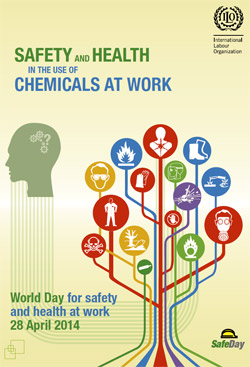 |
|
|
The ILO have issued a new report which reviews the current situation regarding the use of chemicals and their impact in workplaces and the environment, including various national, regional, and international efforts to address them.
The report also presents the elements for establishing national and enterprise level programmes that contribute to ensure the sound management of chemicals at work.
The ILO report calls on governments, employers, workers and their organizations to collaborate in the development and implementation of national policies and strategies aimed at the sound management of chemicals at work. These must comprehensively and simultaneously address the health, safety, and environmental aspects related to the production and use of chemicals. The idea is to maintain the benefits achieved through the production and use of chemicals while minimizing workers’ exposure as well as the emission of chemicals into the environment through national and international action.
A coherent global response is necessary to coordinate the continuous scientific and technological progress, the growth in chemicals production and changes in the organization of work. Likewise, new tools need to be developed to provide readily available information about chemical hazards and risk, and associated preventive and protective measures.
 The ILO website introduces the Chemicals At Work report: The ILO website introduces the Chemicals At Work report:
‘Chemicals are key to healthy living and modern convenience. They range from pesticides that improve the extent and quality of food production, to pharmaceuticals that cure illnesses, and cleaning products that help establish hygienic living conditions. Chemicals are also critical in many industrial processes for developing products important to global standards of living.
However, governments, employers and workers continue to struggle to address controlling exposure to these chemicals in the workplace, as well as limiting emissions to the environment.’
They go on to say:
‘Chemicals pose a broad range of potential adverse effects, from health hazards such as cancers and physical hazards like flammability, to environmental hazards such as widespread contamination and toxicity to aquatic life. Many fires, explosions, and other disasters result from inadequate control of chemicals’ physical hazards.’
Unionsafety has previously reported on the harmful health affects of Aspartame used in soft drinks, baby food and much of our food and drink, and the emerging facts around E-Cigarette technology which has introduced further health risks, according to many researchers.
Then of course there is the use of pesticides and the impact upon the Bee population around the world, not to mention the thousands of tons of the old and now banned pesticide, DDT which has been found in Arctic ice.
The ILO website adds:
‘Significant progress has been made concerning the regulation and management of chemicals in the field of occupational safety and health but more needs to be done. Serious incidents continue to happen and there are still negative impacts on both human health and the environment.
Workers who are directly exposed to hazardous substances should have the right to work in a safe and healthy environment and be properly informed, trained and protected.’
But it warns:
‘It is difficult to determine the extent of health effects in the workplace related to chemical exposures. Because of the complexity of assessing mixtures of chemicals, strategies to prevent harmful exposure tend to focus on individual chemical substances. This is further complicated by the fact that these substances can also be found combined with mixtures in most workplaces. They are rarely assessed or tested in the form of a mixture. Standards for individual chemicals routinely address problems with a single chemical.
Still, the reality is that there are so many chemicals to which workers may be exposed that this substance-by-substance approach will never be able to adequately protect them. Most workers are exposed to mixtures, rather than individual chemical substances, therefore the control of mixed exposures is critical for an effective protective programme. Furthermore, efforts to establish the connection between an exposure to chemicals 20 years ago and a case of cancer today have also been hampered by lack of information about the effects of chemical exposures. Record keeping on effects resulting from exposure to chemicals also needs to be improved.’
The full ILO report, ‘Safety And Health In The Use Of Chemicals At Work’, can be downloaded from the E-Library Database using search category ‘Chemicals’
Source: ILO / CWU / Unionsafety
|
|
|
Designed, Hosted and Maintained by Union Safety Services
|


